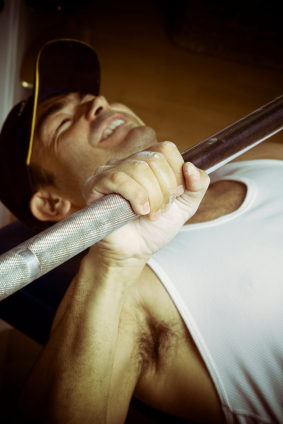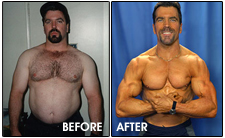|
Bodybuilding: Groundless Theories That Can Hamper Your Chest Growth
by Scott Abbett |
|
I wonder how many of you reading this have used alternating dumbell curls for your biceps. If so, let me ask you this: Have you ever asked yourself why you do them? Think about it; you never perform alternating repetitions for most other exercises. When was the last time you did an alternating leg press, alternating leg extensions, or alternating overhead triceps extensions? Probably never. Yet it’s common to see people copying what they see others do in performing alternating biceps curls. And since they’re resting each arm while lifting the weight in the opposing arm, they’re essentially doing a rest/pause between each repetition when performing curls in this manner. One day in the gym, I asked a guy why he does alternating dumbell curls for his biceps. I pointed out that there aren’t any other muscle groups that get this alternating rest/pause treatment. What benefit was each of his biceps getting from resting as much as five seconds between repetitions? He just scratched his head and looked at the floor. “I don’t know…” he said, smiling. “I’ve never really thought about it”
And this brings up my point. I’m not here to tell people they’re wrong in doing alternating dumbell curls. I’m here to express that they might be cutting themselves short in life when they go through it “never really thinking about it”. We tend to do even less thinking when we perceive the people we’re emulating (like the BIG alternating dumbell curl guy) to be experts. Here’s something to ponder that’s a bit more consequential than whether you alter your dumbell curls. Do you subscribe to the bodybuilding theory that says you need to focus mostly on compound movements to build size? You know the story: to build a big chest, your routine needs to consist of mostly bench pressing – for bigger legs, you’d better do a lot of squats. I’ve heard this over and over again. But is it really true? I’ve gained my best pectoral size after putting bench pressing routines on the back burner in favor of flyes. And I’m not the only one; I first became motivated to do it when I read an article many years ago in which bodybuilding legend Scott Wilson said his chest only grew when he dumped the excessive bench pressing. Think about it: Why would compound movements be better than isolation one’s for building your body? Muscle growth occurs when you advance to moving higher volumes of weight than you previously could. If that happens while doing flat dumbell flyes for your chest, your pecs will get bigger… period. Equally, if you train your chest with bench pressing in a haphazard manner that leads to over-training, your chest won’t get any bigger even though you opted for bench pressing over flyes. It’s that simple. Consider this: let’s say for argument’s sake that your pectoral muscles will move one third of the load when you’re bench pressing. This sounds reasonable since the deltoids and triceps are heavily called upon when performing upper body pressing movements. If you can eke out ten repetitions of 225 pounds on the bench, you’d move a total volume of 2,225 pounds but your pecs might have been called upon for a third of that work; about 742 pounds. It’s safe to bet that a person who can do ten good reps with 225 on the bench can also perform ten strict repetitions of flat bench dumbell flyes with 50 pound dumbbells. However, those strict reps of dumbell flyes would place a significantly greater volume demand directly on the pectorals within the same time allotment required by the bench pressing. The two fifty pound dumbells are a hundred pounds on the whole chest, times ten equals a thousand. That’s a thousand pounds of volume (thirty-five percent more than the bench pressing) placed almost exclusively on the pec muscles. Even if you can only use forty pound dumbells for the flyes, you’ll still beat the bench press for volume load on the pecs (800 lbs vs. 742 lbs). This assumes that your pectorals are indeed taking exactly one-third of the stress during bench pressing. It could be more than that or it could be a bit less; it depends much on the genetically-determined structure of your upper body. What’s in a Hormone Spike? Many compound movement advocates site the theory that the body releases more anabolic hormones when performing big movements like squats and bench presses. To this assertion, I can pose three very good questions: 1. How much additional testosterone can bench pressing produce over isolation movements? (unless it’s huge amounts, it’s not going to matter) 2. Does this increase represent higher average levels of the hormone during recovery, or is it only a spike during and directly after a workout? (don’t buy the “two-hour window” theory) 3. All other things considered – does it really matter? Here’s an even better question: If one guy does his bench pressing in a wimpy manner and another guy does his flyes like his life depends on it – who gets the best testosterone spike? Another question: Since sexual activity also spikes testosterone levels, does the heavy flye user who has sex after his workout produce more testosterone than the bench presser who doesn’t? I think you get my point. Natural testosterone ebbs and flows in everyone (women too). It’s really the levels we average during our entire recuperation period between workouts that matters. And how much does that matter? If you average a few nanograms per decileter more than I do, I’ll probably just take one more day off between workouts and make just as much muscular gain as you. Form Matters on Flye Movements To build your chest with flyes, good form is absolutely essential. All too often, I see people performing movements that resemble a sort of hybrid between flyes and dumbell presses. These are about the most useless things you can do for your pecs. Your elbows do need to be slightly bent during flyes to prevent hyper-extending them. However, pivoting at the elbows instead of the shoulders is just a sneaky way of deferring or avoiding discomfort. Let’s face it, doing heavy flyes in a strict and disciplined manner is painful. When relatively heavy dumbells are lowered with outstretched arms until they’re horizontal and even with your head on the bench, there’s a searing kind of stress throughout the chest region. When you squeeze the muscles as you carefully arc the dumbells upward and back together, the pain and positive effect from working the pecs so directly is only intensified. This is a good indication that you’re doing them correctly. Conclusion I currently do only one compound movement during my chest workout and the rest of it consists of flyes and pec-deck exercises. What’s more, I do my bench pressing movement late in the workout so that my pectorals have become somewhat pre-exhausted. This has all led to far greater pectoral growth compared to the days when I did set after set of flat and incline bench pressing. If you’re having trouble with pectoral growth, I suggest you try a flye and pec-deck dominated workout routine. Let go of the erroneous belief that these are “shaping exercises”. Consider this: Ray “Thunder” Stern, a bodybuilder from the distant past, had some of the best pectoral muscles I’ve ever seen when he was at his peak. It was said by some of his friends that he could perform incline dumbell flyes with a pair of 120-pound dumbells. That’s incredible. Impressive flye movements will produce an impressive chest. |




